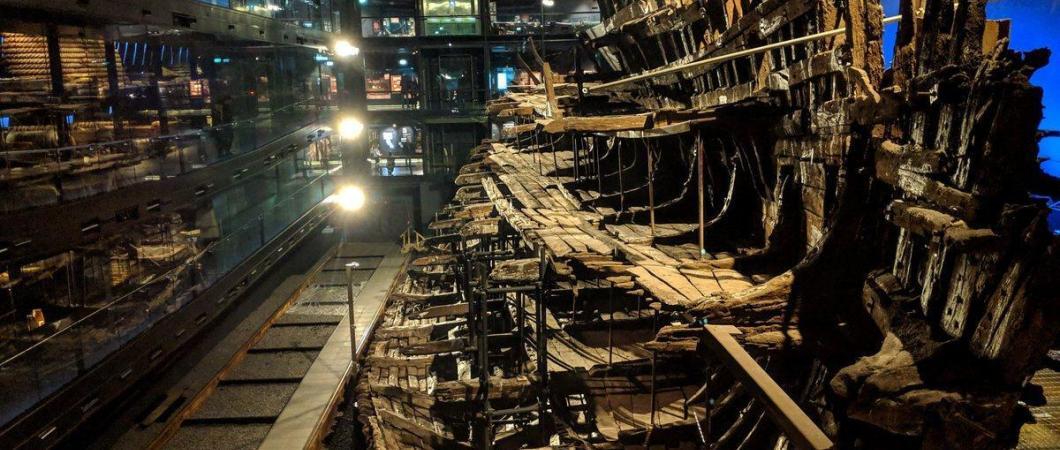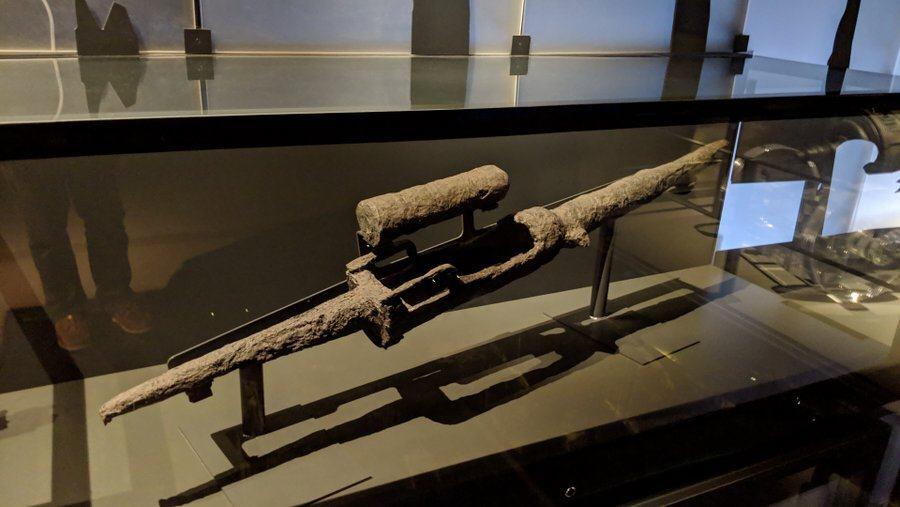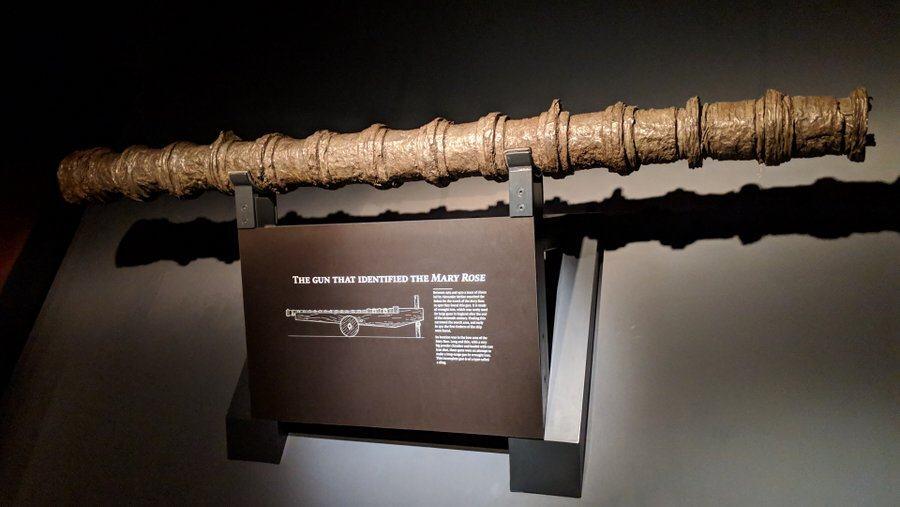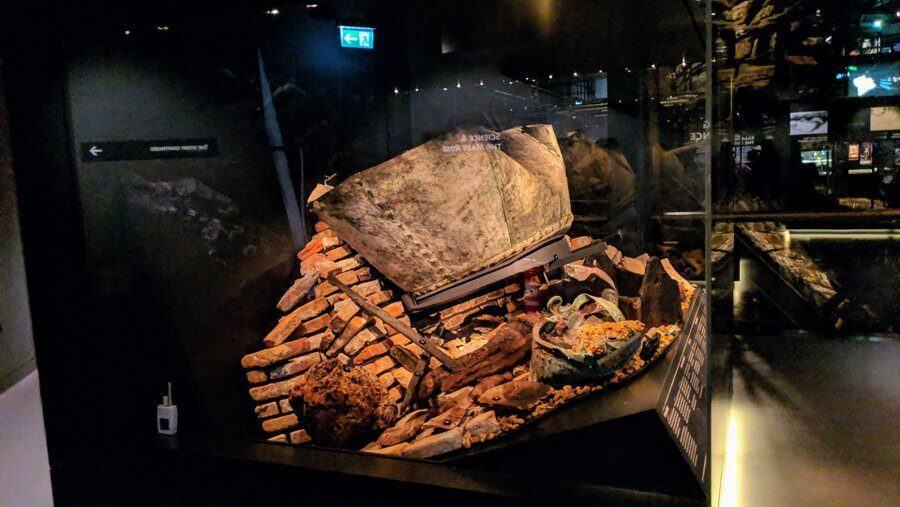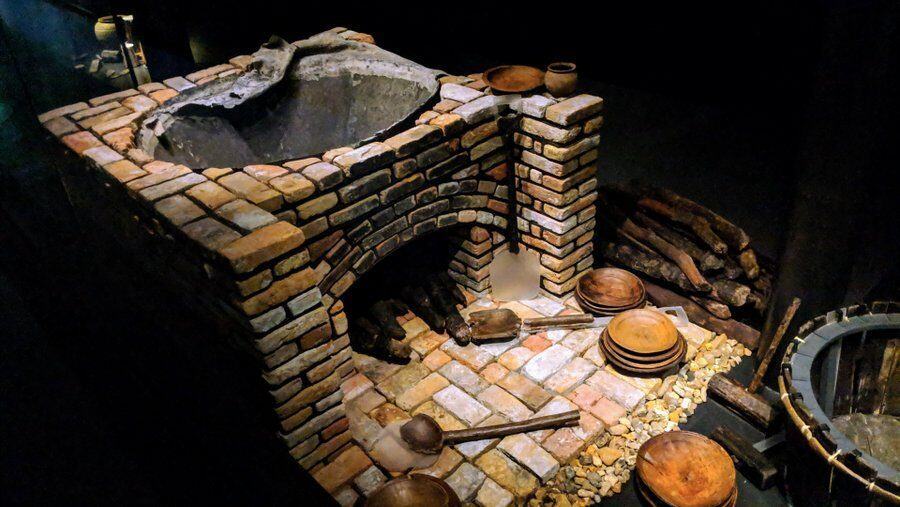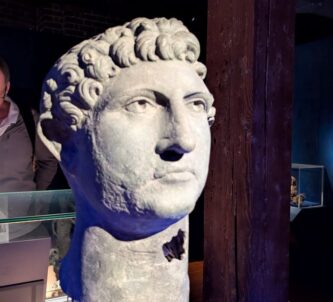The Mary Rose is one of Britain’s most important historic artefacts and should be on everyone’s ‘Must See’ list.
When she sank into the silt of the Solent almost five centuries ago (474 yrs), she became a Tudor time capsule containing the personal effects, weapons, tools, clothing, utensils, and musical instruments of her 500 crew members… and their DNA. It’s been almost 40 years since she was raised, and we are still learning from her. Last month scientists from Cardiff and Portsmouth universities reported that the DNA and bone structures of 10 skeletons from the wreck show the crew were more diverse than assumed. Four of them were of southern European heritage, and one is North African.

The bones of 179 men (and a dog) were found in and around Mary Rose. Most of them (80%) were under 30 years old, and some were as young as 13.
The History
At the start of the 16th century, King Henry VIII was facing threats from the French and the Scots. He needed to build a professional naval fleet to keep them at bay.
This was a new technological era and Mary Rose was a state-of-the-art warship when she was built in Portsmouth between 1509-1511. Previously, warships were built like floating castles packed with archers and soldiers who would grapple and board enemy ships. New shipbuilding techniques and new gun technology allowed shipbuilders to install canon firing through ports in the hull. Now in the early 16th century, warships like the Mary Rose could pound and sink the enemy (not the prefered choice, they would rather capture them), while her thick oak hull, cut from 600 trees, would help protect her from the same fate.
At 45 metres overall length, with 4 masts and 91 guns, Mary Rose was the larger of Henry’s first two ‘newbuilds’¹ for the fleet and so became the flagship of Lord High Admiral, Sir Edward Howard. In the First French War (1512 – 1514) the fleet engaged in raids around Brittany and carried troops to northern England to tackle the Scots (Battle of Flodden).
During the Second French War (1525-1542) the Mary Rose helped escort troops over to France, but for the most part she was kept in reserve. In 1536 she underwent a refit, which some historians suggest may have contributed to her fate by altering her stability. Extra bracing was fitted, probably needed to carry extra weight, and there is some suggestion that extra gunports were cut in the hull.
In 1543 the Third French war broke out and by May 1545 both sides were amassing ships. The French gathered around 225 ships for an invasion, while the English fleet gathered 80 ships to defend the south coast. The two fleets skirmished in the Solent on 18th July. Then when the English came back out to rejoin battle the next day, the Mary Rose, now the flagship of Vice-Admiral George Carew, suddenly and inexplicably foundered and sank leaving only 34 survivors, an elated French navy, and a dejected English king (Henry VIII) who had been watching from Southsea Castle.
It is perhaps the similarities – a flagship heeling over and dramatically sinking in front of the king – that causes confusion with the demise of Sweden’s Vasa 83 years later. Many people think that Mary Rose sank on her first voyage, but in fact she had a proud war record stretching over three decades.
Recent History
The wreck of the Mary Rose was discovered on the seabed in 1971… or rather, half of her was discovered ‘in’ the seabed. Over the years she had rolled to starboard and settled into the mud. The exposed half rotted away, but the buried half was preserved, looking, as it was pulled from the water in 1982, like a cutaway model of the ship.
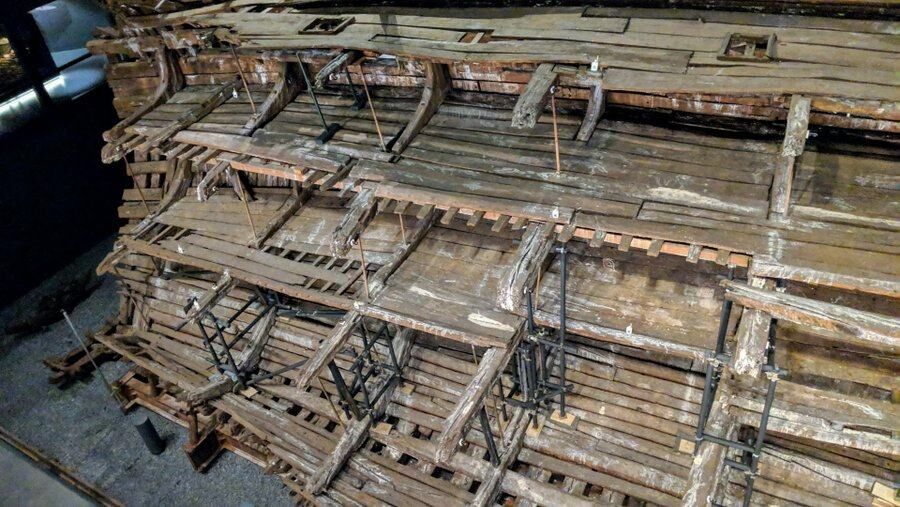
She was moved immediately into Dock 3 at Portsmouth’s Historic Dockyard, but, after those centuries under the sea and now exposed to the air, the timbers of the ship were so fragile, they had to be sprayed continuously with fresh water to prevent them rotting and collapsing under their own weight. The water treatment, followed later by a chemical wax spray (polyethylene glycol), lasted for thirty years. Then finally the wreck was sealed in a “hotbox” to dry out.
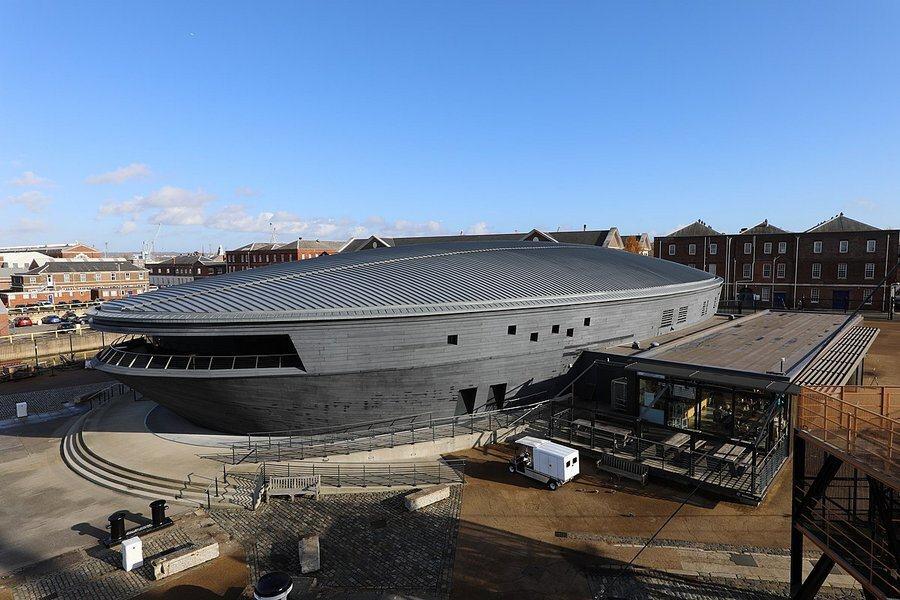
The hotbox was part of the spectacular new museum built around Mary Rose, designed to display her and many of her 19,000 artifacts, in the most dramatic way. Finally, in 2016 the “hotbox” glass walls were removed allowing visitors to see her directly ‘in the flesh’, so to speak.
The Mary Rose museum now
It has to be said, the museum is a masterpiece of design². The ship herself is the centrepiece with her artifacts displayed in multi-floor galleries around her, particularly at each end. The really clever bit is that the galleries align with her exposed decks and display the items that were found there.
The conservation process still continues in a climatically controlled environment, but visitors can now look down on her from a balcony on the top floor accessed through large air locks at each end. (No, you don’t have to climb through a heavy steel door with a little porthole and a large wheel to lock it! It’s more like a large glass-walled room. You just have to wait for the automatic glass door behind to close before the one in front opens.)
There is a lighting cycle. Every ten minutes or so the lights on Mary Rose dim and she comes alive with projected animations of crew members going about their routine in various parts of the ship. It’s a clever idea that gives visitors a sense of what they are looking at, rather than a just a jumbled collection of ribs and decking.
Lighting is not always great. For most of the light cycle on the Mary Rose herself, it is rather gloomy. That said, there is a short bright period and that is the moment to take photos if you want to! It may be that the subdued lighting is for conservation reasons, and many museums use a general low light level as a display tool so they can guide the eye by highlighting key exhibits. All the same I found myself peering through the dark too often for my liking.
Highlights for me
You can never have too many longbows!Mary Rose was armed to the teeth. Ninety-one cannon of varying sizes and at least 1,635 cannonballs were found on board; 150 pikes; 150 bills (spear with a hooked blade); dozens of swords & daggers; 50 handguns including some “shield guns” (small shield with a gun in the boss), but my interest was piqued by the…
- Chest of Longbows – You can never have too many longbows! She had 250 longbows listed in her inventory of which 137 were found, together with 3,500 of her 4,000 listed arrows.
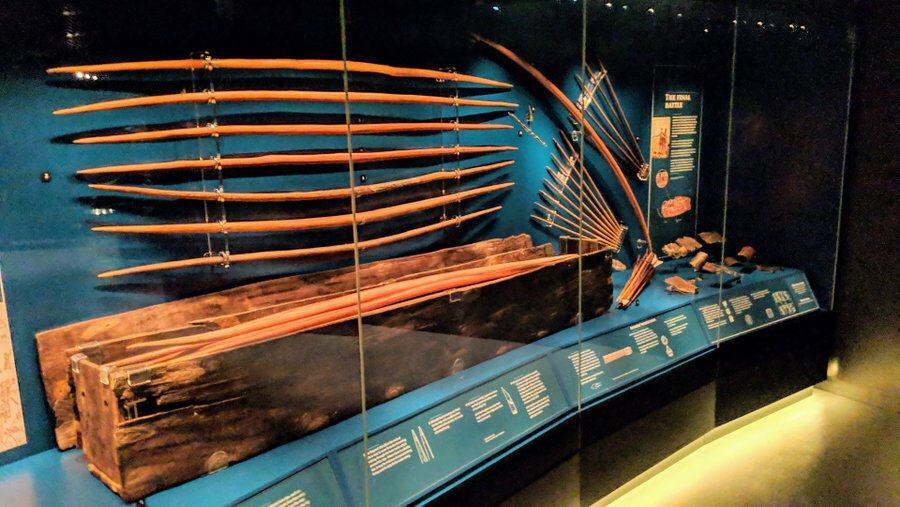
Chest of longbows - The Iron Guns – The big bronze guns are impressive, but I thought the (lighter) iron cannon from the upper decks were particularly interesting… if a little rusty! The banded barrel cannon found near the bow of Mary Rose and the swivel gun from the upper castle deck, look more primitive than the bronze front-loading cannon, but they were early forms of breech loaders.
- The Carpenter’s Rulers – It never occured to me that there would be a “Tudor inch” which was slightly smaller than the inch as we know it!

A set of rulers with the markings still clear - Navigational Instruments – As an amateur navigator (analogue!) I’m always interested in old nav tools (cross-staffs, quadrants, compasses, logs, leads, rutters, charts, etc), so the compass boxes, the first known example of compasses mounted in gimbals, are special.
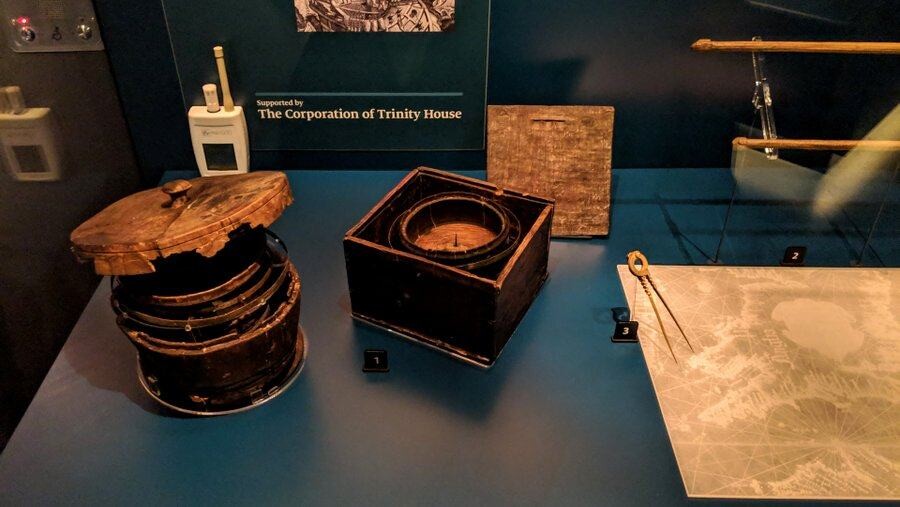
Compass boxes - The Parrel – A lovely piece of wood & ropework, the Parrel is a piece of rigging. It binds a yard to a mast, but allows it to be raised & lowered. This one looks unused. It was found in a storage room on the Orlop deck and would be used on either of the two foremasts.
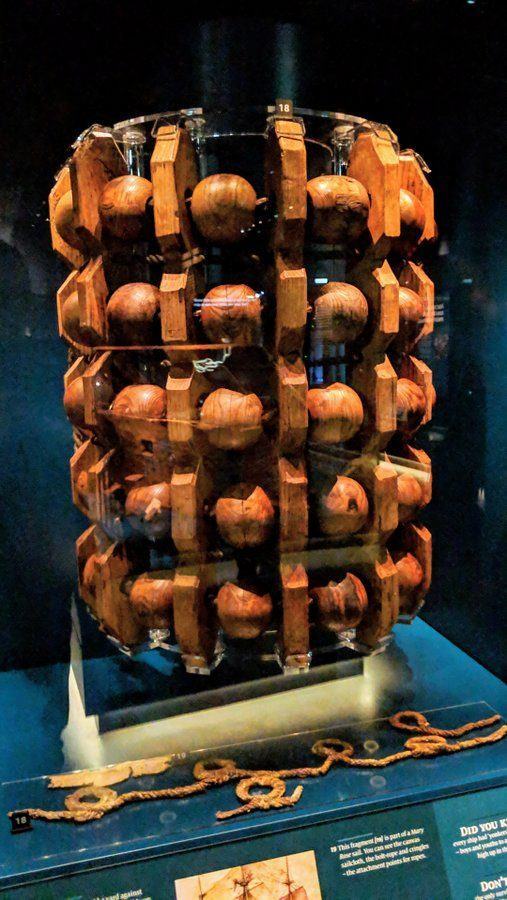
The Parrel - The Galley – The galley is fascinating. There are two on display: the galley as found in the Hold, and the galley as it would have been.
Ticketing
Until Apr 2018 entry to Mary Rose was included in the Portsmouth Historic Dockyard multi-attraction tickets, but the Mary Rose Trust has now gone its own separate way – a MREXIT, if you like!
I think this is an unfortunate move. It’s not that Mary Rose is overpriced. It’s that, in the context of a visit to the Historic Shipyard, she is overpriced. It turns her from an attraction you might visit and enjoy on multiple occasions over the years, to a single-visit attraction. (Tickets for NMRN attractions and Mary Rose are valid for a year, so you can make multiple visits within that first year, but on a future visit to Portsmouth are you going to buy a NMRN ticket for all the attractions except Mary Rose… and then another for Mary Rose?)
Mary Rose is a historic icon, a national treasure, displayed fabulously. You have to see her, though you might grit your teeth when you buy your ticket, because fifty feet away is another national treasure, HMS Victory, and depending which multi-attraction ticket variant you buy from the National Museum of the Royal Navy (NMRN), you can see HMS Victory and some or all of the other NMRN attractions (in Portsmouth that’s HMS Warrior, HMS M33, plus the Submarine museum and the Explosion! museum on the other side of the harbour).
TBF I’m not really blaming the Mary Rose Trust. I suspect they have some large investments to recoup on their spectacular building and the ongoing costs of preservation, but from a consumer perspective, whether you buy online or at the TWO(!) ticket offices at the dockyard entrance, it is not ideal.
Other Portsmouth Posts
| Portsmouth Historic Dockyard | HMS Victory & Nelson | HMS M33 |
| Mary Rose | Submarine Museum | Explosion! |
| HMS Warrior | D-Day Story | Visiting Portsmouth |
¹ The Peter Pomegranate was built first in 1510.
² The design was a collaboration between by architects Wilkinson Eyre who designed the building, and designers Pringle Brandon Perkins+Will, who designed the galleries.
Declaration: No need. I was visiting Portsmouth on my own. All entrance fees, accommodation, petrol, etc paid by me.
Factbox
Mary Rose is located in the Portsmouth Historic Dockyard.
Website:
Mary Rose
Getting there:
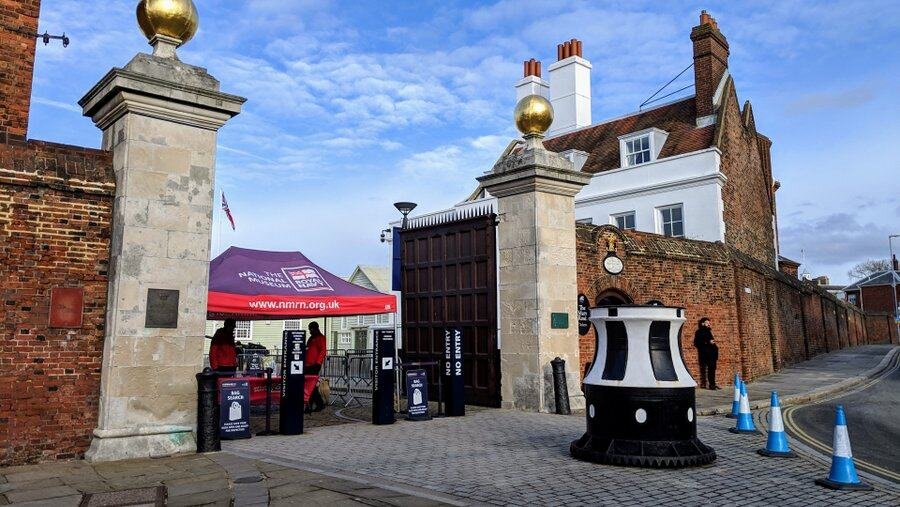
The Historic Dockyard is, naturally, right at the heart of Portsmouth. The entrance, Victory Gate, is at the junction where Queens St becomes The Hard, a hundred yards from Portsmouth Harbour rail station and the bus station.
If you are driving, you can make use of the Park + Ride scheme from the outskirts of Portsmouth, which of course is cheap as chips! (£4 per day). Or the Historic Dockyard has parking for 295 cars (follow the brown tourist signs) and within easy walking distance is the Gunwharf Quays shopping centre car park.
Entry Price:
Tickets give unlimited entry for 12 months from purchase date.
| Online price | Price at the door | |
|---|---|---|
| Adult | £14.40 | £18.00 |
| Concession (aged 60+) | £13.60 | £17.00 |
| Student (valid student card required) | £13.60 | £17.00 |
| Child (aged 5-15) | £6.80 | £8.50 |
| Family (1 adult + 3 children) | £21.20 | £26.50 |
| Family (2 adults + 3 children) | £30.80 | £38.50 |
As mentioned above, the Portsmouth Historic Dockyard Full Navy Ticket, or the one, two or three attraction day tickets, don’t include Mary Rose. However if you turn up at the Mary Rose ticket office with one of those, or a NMRN National Membership card, they’ll give you a 10% discount.
Opening Hours:
| November – March | 10am-5pm (last entry 4:15pm) |
| April – October | 10am-5:30pm (last entry 4:45pm) |
| 24 – 26th December | CLOSED |
| New Year’s Day | 11am-5pm |

